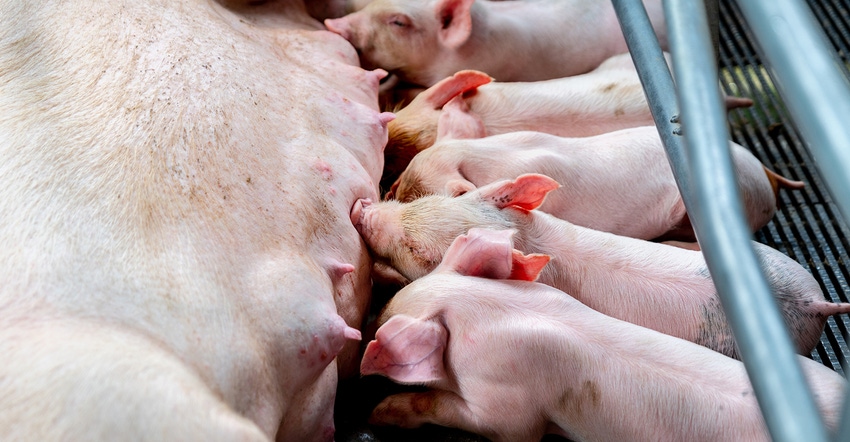Piglet performance starts with the sow
Producers often think that developing healthy piglets starts with the piglets, but sow gut health is the true key to growing healthy piglets.
October 1, 2020

Sponsored Content
Weaning healthy, high-performing piglets depends on multiple factors. Genetics, biosecurity, nursery hygiene and housing ventilation all play roles. But for most swine operations, sow health is the number one factor in optimal piglet performance.
An aspect of sow health that's often overlooked is her microbial environment. Research shows that proactively managing the sow's microbial population through her feed can reduce harmful pathogens and improve litter performance.
Why vaccination is not enough.
We often think of vaccination as a key strategy for managing sow health and controlling disease in young pigs. Indeed, vaccinating the sow is an important step to deliver immunity to her offspring through colostrum and milk production. Unfortunately, the passive protection provided through sow vaccines wanes before the piglet fully develops its own strong immune system.
Meanwhile, the lactating sow transfers more than immunity to her litters. During and after farrowing, she also transfers a microbial population from her body to the environment that then colonize the newborn piglets' gastrointestinal tracts. These microorganisms include beneficial populations that are critical for healthy microbial ecology, as well as harmful bacteria that can cause diseases in the young, naïve pig.
Even healthy sows can harbor potentially pathogenic bacteria because their mature immune systems allow them to fend off the diseases they cause. ARM & HAMMER™ lab analyses of sow fecal samples from commercial swine production operations show large populations of E. coli and Clostridium, including pathogenic strains.
Since much of the microbial community in the farrowing crate and on the sow's udder is derived from fecal material, it's not surprising that E. coli and Clostridium bacteria commonly affect piglet health. Pathogenic strains of E. coli commonly cause scours in piglets, and Clostridium perfringens is associated with piglet diarrhea and sudden death.
Gut microbiology matters.
All these early microbial exposures influence how the pig's immune system develops and functions, how the pig responds to stresses, and how the animal uses nutrients for body maintenance and growth throughout its life.
Producers often rely on antibiotics as tools for managing disease-causing microbial populations in sows and pigs throughout all swine production phases. Whether antibiotics are targeted against respiratory or gastrointestinal disease, many of them indiscriminately reduce the microbial load --reducing not only harmful organisms, but also beneficial populations needed for a healthy gut microbial ecology.
Better ways to manage microbial populations.
A better way to manage the sow's gastrointestinal microbiology is by feeding the Targeted Microbial Solutions™ in CERTILLUS™. This probiotic approach uses proprietary strains of Bacillus subtilis to specifically target the E. coli and Clostridium populations in the gut and reduce their prevalence in favor of beneficial lactic acid bacteria (LAB).
Research at a commercial swine facility in Minnesota1,2 evaluated the effect of CERTILLUS fed to 500 sows from three days after breeding through gestation and lactation. Results show that feeding CERTILLUS to sows reduces the pathogen load in the farrowing environment and helps colonize beneficial LAB in piglet gastrointestinal tracts.
Test of sow fecal samples at farrowing showed that feeding CERTILLUS reduced fecal E. coli content by 60 percent compared with controls not fed CERTILLUS. Fecal samples of piglets three days post-weaning showed higher LAB counts in pigs weaned from sows fed CERTILLUS.
Improved microbial environment during lactation and colonization of beneficial bacteria in piglets translated to improved growth and performance in the nursery period. Pigs weaned from sows fed CERTILLUS during lactation had 33 percent higher average daily gain (ADG) and 24 percent greater feed efficiency (G:F).
Overall, pigs weaned from sows fed CERTILLUS were 2 lbs. (.91 kg) heavier at the end of the 51-day nursery period compared with pigs weaned from control sows. If carried out through finishing, that weight advantage would translate to one to two fewer days to market.
To learn more about how feeding CERTILLUS to sows supports piglet performance, read this research report.
1 Sinn S, Beckler D. Evaluation of feeding Evosure with and without DFM on sow and litter performance. 2016. NutriQuest Modeling Center.
2 Sinn S, Beckler D. Evaluation of feeding Evosure, DFM, and their combination to sows during gestation and lactation on growth performance of their offspring during the post-weaning phases. 2016. NutriQuest Modeling Center.
About the Author(s)
You May Also Like


.png?width=300&auto=webp&quality=80&disable=upscale)
